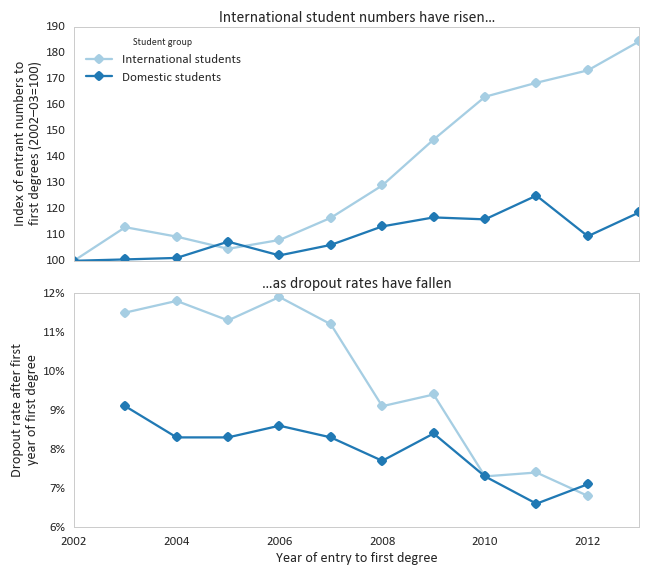The Higher Education Funding Council for England (Hefce) recently published the latest figures on students who drop out after their first year of study. These are an important indicator for the sector because dropping out is costly to the university, the student and society.
This update, which tracks students who began their studies in 2012-13, is particularly interesting because it is the first time that data on international, non-EU students has been published.
International student numbers have risen by nearly 70 per cent over the past decade, increasing from 31,000 first-degree entrants in 2003-04 to 51,000 in 2013-14.
International students tend to pay higher fees than domestic and EU students, which has led to universities becoming increasingly reliant on their fee income. Universities UK’s latest report finds that international students’ fees now contribute nearly 30 per cent of the sector’s tuition fee income in 2013-14, despite international students accounting for only 13 per cent of enrolments.
That makes dropouts after the first year of study a significant source of lost income for universities.
For the students, a wasted year is also costly. By dropping out after their first year, students miss out on much of the value of a university education.
The OECD estimates a first degree to be worth a net £140,000 to an average UK student. However, those who drop out after completing their first year of university reap no financial benefit. Even if they go on to study elsewhere, outside the UK, that lost year will have been an expensive mistake.
The good news is that, as international student numbers rose from 2006-07, universities began to tackle their previously high dropout rates. International dropouts have declined since the mid-2000s and reached parity with domestic students by 2010-11.

The data do not show the reasons why students dropped out, which makes it difficult to know exactly what has changed. Students drop out of university for many reasons, including personal problems, academic failure, poor course choice and lack of support.
The fall in dropouts may be due to a combination of better selection of universities, or courses, and better support for international students once enrolled. That is supported by figures showing that UK universities now have the highest satisfaction ratings of any anglophone nation among international students.
Universities’ efforts were aided by Hefce’s introduction of funding to improve retention in 2002-03. This helped universities to improve the infrastructure that supports students most at risk of dropping out. That includes identification of the students, recruitment of staff with specialised knowledge and improving skills that aid retention.
The improvements are not limited to young students, with the data showing that the greatest fall in international students’ dropout rates has been among mature students. Mature international students’ dropout rates are now a third lower than those of domestic mature students.

The remarkable improvement in international dropout rates may hold lessons for domestic students; however, further research would be required to understand the reasons for dropouts and the levers at universities’ disposal.
James Zuccollo is senior economist at the Higher Education Funding Council for England (Hefce). This blog post was originally published on Hefce’s website.




